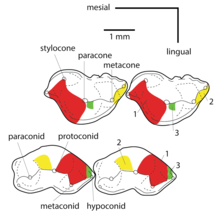Kuehneotherium
|
Kuehneotherium Temporal range: Late Triassic - Early Jurassic, 220–195 Ma |
|
|---|---|
 |
|
| Upper and lower molars of Kuehneotherium | |
| Scientific classification | |
| Kingdom: | Animalia |
| Phylum: | Chordata |
| Class: | Mammalia |
| Family: | †Kuehneotheriidae |
| Genus: |
†Kuehneotherium D.M. Kermack et al., 1968 |
| Type species | |
|
†Kuehneotherium praecursoris D.M. Kermack et al., 1968 |
|
Kuehneotherium is an early mammaliaform genus that lived during the late Triassic period and is characterized by reversed-triangle pattern of molar cusps. Although a large number of fossils have been found, the fossils are limited to teeth, dental fragments, and mandible fragments. The genus includes Kuehneotherium praecursoris and all related species. It was first named and described by Doris M. Kermack, K. A. Kermack, and Frances Mussett in November 1967. The family Kuehneotheriidae and the genus Kuehneotherium were created to house the single species Kuehneotherium praecursoris. Modeling based upon a comparison of the Kuehneotherium jaw with other mammals indicates they were about the size of a modern day shrew between 4 and 5.5 g at adulthood.
Kuehneotherium is thought to be an insectivore that could consume only soft-bodied insects such as moths. Their teeth were shaped for vertical shearing and could not crush harder prey. They lived alongside another early mammal, Morganucodon, which had teeth that could crush harder insects such as beetles. This distinction in diet shows that early mammals adapted to have a separate feeding niche so they would not compete for food.
Remains of Kuehneotherium praecursoris have been found in the Pontalun Quarry in a single fissure pocket in South Wales. The deposit found in limestone is from the Late Triassic. (Whiteside and Marshall 2008) Additional Kuehneotherium fossils have been found in rock formations of the Early Jurassic of Britain (Somerset), and the Late Triassic of France (Saint-Nicolas-de-Porte), Luxembourg, and Greenland; the Kuehneotherium specimens for Saint-Nicolas-de-Porte have been named K. stanislavi.
During the Late Triassic Period the supercontinent Pangaea was intact, allowing easy interchange and migration of mammals across the connected continents. This explains the wide distribution of Kuehneotherium fossils found throughout Greenland and Europe. When the continents began to rift apart during the Jurassic, shallow seas covered the British Isles, where Kuehneotherium was first found. Mammal remains were swept into limestone caves and fissures formed by the shallow seas and were preserved as fossils in clastic sediment.
...
Wikipedia
